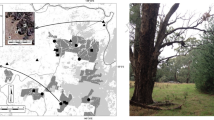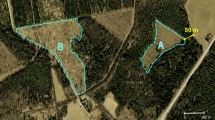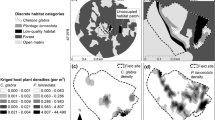Abstract
We experimentally examined edge effects and movement patterns of the butterfly Parnassius smintheus in two habitat types, its preferred meadow habitat, and intervening forest matrix habitat. We followed the movement of 46 butterflies released at either 5 or 20m from a forest edge in either forest or meadow habitat. In contrast to theoretical predictions, we found that butterflies flew less frequently, shorter distances, and at lower rates in matrix habitat than they did in meadow habitat. Distance from the edge had little effect on these aspects of movement. Flight was strongly influenced by light levels with butterflies flying more readily at higher light levels. Light levels were higher in meadows than in forest explaining much of the difference in movement patterns. Turning angles showed that butterflies flying in meadow habitat avoided forest edges and that this effect extended nearly 25 m into meadows. Analysis of net displacement from the forest edge reinforced this result and showed that there may be attraction to the meadow for butterflies flying within forest.
Similar content being viewed by others
References
M. Belisle A. Desrochers (2002) ArticleTitleGap-crossing decisions by forest birds: an empirical basis for parameterizing spatially-explicitindividual-based models Landscape Ecology 17 219–231
D.R. Bowne J.D. Peles G.W. Barrett (1999) ArticleTitleEffects of landscape structure on movement patterns of the hispid cotton rat (Sigmodon hispidus) Landscape Ecology 14 53–65
C.L. Brdar (2000) Limits to butterfly movement in a successional landscapeM Sc. Thesis University of AlbertaEdmonton, AlbertaCanada
E.F. Connor S.H. Faeth D. Simberloff (1983) ArticleTitleLeafminers on oak: the role of immigration and in situ reproductive recruitment Ecology 64 191–204
E.E. Crone D. Doak J. Pokki (2001) ArticleTitleEcological influences on the dynamics of a field vole metapopulation Ecology 82 831–843
P.R. Ehrlich (2003) Butterflies, test systems, and biodiversity C.L. Boggs W.B. Watt P.E.R. Ehrlich (Eds) Butterflies: ecology and evolution taking flight University of Chicago Press ChicagoUSA
S. Fownes J. Roland (2002) ArticleTitleEffects of meadow suitability on female behaviour in the alpine butterfly, Parnassius smintheus Doubleday Ecological Entomology 27 457–466
J.F. Gobeil M.A. Villard (2002) ArticleTitlePermeability of three boreal forest landscape types to bird movements as determined from experimental translocations Oikos 98 447–458
N.M. Haddad (1999) ArticleTitleCorridor and distance effects on interpatch movements: a landscape experiment with butterflies Ecological Applications 9 612–622
I. Hanski (1994) ArticleTitleA practical model of metapopulation dynamics Journal of Animal Ecology 63 151–162
I. Hanski (1999) Metapopulation Ecology Oxford University Press OxfordUK
S. Hein J. Gombert T. Hovestadt H. Poethke (2003) ArticleTitleMovement patterns of the bush cricket Platycleis albopunctata in different types of habitat: matrix is not always matrix Ecological Entomology 28 432–438
J. Ide (2002) ArticleTitleMating behaviour and light conditions cause seasonal changes in the dispersal pattern of the satyrine butterfly Lethe diana Ecological Entomology 27 33–40
I.D. Jonsen R.S. Bourchier J. Roland (2001) ArticleTitleThe influence of matrix habitat on Aphthona flea beetle immigration to leafy spurge patches Oecologia 127 287–294
N. Keyghobadi J. Roland C. Strobeck (1999) ArticleTitleInfluence of landscape on the population genetic structure of the alpine butterfly Parnassius smintheus (Papilionidae) Molecular Ecology 8 1481–1495 Occurrence Handle10564454
T. Kuras J. Benes A. Celechovsky V. Vrabec M. Konvicka (2000) Parnassius mnemosyne (Lepidoptera: Papilionidae) in North Moravia: review of present and past distribution, proposal for conservation Klapalekiana 36 93–112
M. Kuussaari M. Nieminen I. Hanski (1996) ArticleTitleAn experimental study of migration in the butterfly Melitaea cinxia Journal of Animal Ecology 65 791–801
M.F. Land (1997) ArticleTitleVisual acuity in insects Annual Review of Entomology 42 147–177 Occurrence Handle1:CAS:528:DyaK2sXjvFSmtA%3D%3D Occurrence Handle15012311
S.L. Lima L.M. Dill (1990) ArticleTitleBehavioral decisions made under this risk of predation: a review and prospectus Canadian Journal of Zoology 68 619–640
S.F. Matter (1996) ArticleTitleInterpatch movement of the red milkweed beetleTetraopes tetraophthalmus: individual responses to patch size and isolation Oecologia 105 447–453
S.F. Matter (1997) ArticleTitlePopulation density and area: the role of within and between patch processes Oecologia 110 533–538
S.F. Matter J. Roland (2002) ArticleTitleAn experimental examination of the effects of habitat quality on the dispersal and local abundance of Parnassius smintheus Ecological Entomology 27 308–316
Matter S.F., Roland J., Moilanen A. and Hanski I. 2004. Migration and survival of Parnassius smintheus: detecting effects of habitat for individual butterflies. In Press, Ecological Applications.
S.F. Matter J.F. Zawacki M.A. Bowers (1996) ArticleTitleHabitat fragmentation and the perceived and actual risk of predation Virginia Journal of Science 47 19–27
T. Merckx H. van Dyck B. Karlsson O. Leimar (2003) ArticleTitleThe evolution of movements and behaviour at boundaries in different landscapes: a common arena experiment with butterflies Proceedings of the Royal Society of London Series B 270 1815–1821 Occurrence Handle12964984
A. Moilanen I. Hanski (1998) ArticleTitleMetapopulation dynamics: effects of habitat quality and landscape structure Ecology 79 2503–2515
A. Moilanen M. Nieminen (2002) ArticleTitleSimple connectivity measures in spatial ecology Ecology 83 1131–1145
J. Pither P.D. Taylor (1998) ArticleTitleAn experimental assessment of landscape connectivity Oikos 83 166–174
S.R. Pryke M.J. Samways (2001) ArticleTitleWidth of grassland linkages for the conservation of butterflies in South African afforested areas Biological Conservation 101 85–96
H. Pulliam (1988) ArticleTitleSources, sinks, and population regulation American Naturalist 132 652–661
G. Racette G. Chouinard C. Vincent S.B. Hill (1992) ArticleTitleEcology and management of plum CurculioConotrachelus nenuphar (ColeopteraCurculionidae), in apple orchards Phytoprotection 73 85–100
L. Ries D.M. Debinski (2001) ArticleTitleButterfly responses to habitat edges in the highly fragmented prairies of Central Iowa Journal of Animal Ecology 70 840–852
T.H. Ricketts (2001) ArticleTitleThe matrix matters: effective isolation in fragmented landscapes American Naturalist 158 87–99
J. Roland N. Keyghobadi S. and Fownes (2000) ArticleTitleAlpine Parnassius butterfly dispersal: effects of landscape and population size Ecology 81 1642–1653
R.L. Rutowski L. McCoy M.J. Demlong (2001) ArticleTitleVisual mate detection in a territorial male butterfly (Asterocampa leilia): effects of distance and perch location Behaviour 138 31–43
N. Schtickzelle M. Baguette (2003) ArticleTitleBehavioural responses to habitat patch boundaries restrict dispersal and generate emigration-patch area relationships in fragmented landscapes Journal of Animal Ecology 72 533–545
C.B. Shultz E.E. Crone (2001) ArticleTitleEdge-mediated dispersal behavior in a prairie butterfly Ecology 82 1879–1892
D. Simberloff J.A. Farr J. Cox D.W. Mehlman (1992) ArticleTitleMovement corridors – conservation bargains or poor investments? Conservation Biology 6 493–504
C.D. Thomas M.C. Singer D.A. Boughton (1996) ArticleTitleCatastrophic extinction of population sources in a butterfly metapopulation American Naturalist 148 957–975
L. Tischendorf L. Fahrig (2000) ArticleTitleOn the use and measurement of landscape connectivity Oikos 90 7–19
P. Turchin (1991) ArticleTitleTranslating foraging movements in heterogeneous environments into the spatial distribution of foragers Ecology 72 1253–1266
R. Vä;isä;nen P. Somerma (1985) ArticleTitleThe status of Parnassius mnemosyne (LepidopteraPapilionidae) in Finland Notulae Entomologica 65 109–118
Author information
Authors and Affiliations
Corresponding author
Rights and permissions
About this article
Cite this article
Ross, J., Matter, S. & Roland, J. Edge avoidance and movement of the butterfly Parnassius smintheus in matrix and non-matrix habitat. Landscape Ecol 20, 127–135 (2005). https://doi.org/10.1007/s10980-004-1010-8
Received:
Accepted:
Issue Date:
DOI: https://doi.org/10.1007/s10980-004-1010-8




